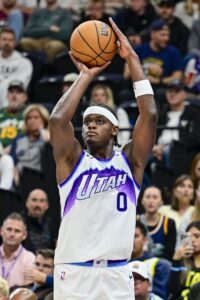The term “poison pill” doesn’t actually show up in the NBA’s Collective Bargaining Agreement, but it’s used colloquially to refer to a provision in the CBA that affects players who recently signed rookie scale contract extensions.
As we explain in our glossary entry, the so-called poison pill provision applies when a player who signed a rookie scale extension is traded before the extension takes effect.
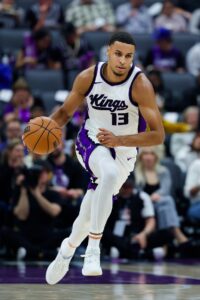 In that scenario, the player’s incoming value for the receiving team for matching purposes is determined by averaging his current-year salary and the salaries in each year of his new extension (including any option years). His current team, on the other hand, simply treats his current-year salary as the outgoing figure for matching purposes.
In that scenario, the player’s incoming value for the receiving team for matching purposes is determined by averaging his current-year salary and the salaries in each year of his new extension (including any option years). His current team, on the other hand, simply treats his current-year salary as the outgoing figure for matching purposes.
For instance, Kings forward Keegan Murray is earning a $11,144,093 salary in 2025/26, but signed a five-year, $140MM extension that will begin in ’26/27.
Therefore, if Sacramento wanted to trade Murray this season, his outgoing value for salary-matching purposes would be $11,144,093 (this year’s salary), while his incoming value for the team acquiring him would be $25,190,682 (this year’s salary, plus the $140MM extension, divided by six years).
If a player has signed a maximum-salary rookie scale extension, his future salaries are calculated based on the assumption that the following season’s salary cap will increase by 4.5% and that he won’t achieve the performance criteria for any Rose Rule language included in his deal.
[RELATED: 2025 NBA Rookie Scale Extension Recap]
Most of the players who signed rookie scale extensions aren’t realistic candidates to be traded anytime soon. But even in the event that a team does want to look into trading one of these recently extended players, the gap between the player’s incoming trade value and outgoing trade value could make it a real challenge to find a deal that works for both sides — especially if a team is operating in or near tax apron territory.
The “poison pill” provision applies to nine players who signed rookie scale extensions in 2025. Here are those players, along with their outgoing salaries and incoming salaries for trade purposes:
| Player | Team | Outgoing trade value | Incoming trade value |
|---|---|---|---|
| Paolo Banchero | ORL | $15,334,769 | $41,610,606 |
| Chet Holmgren | OKC | $13,731,368 | $41,343,373 |
| Jabari Smith Jr. | HOU | $12,350,392 | $22,391,732 |
| Keegan Murray | SAC | $11,144,093 | $25,190,682 |
| Shaedon Sharpe | POR | $8,399,983 | $19,679,997 |
| Dyson Daniels | ATL | $7,707,709 | $21,541,542 |
| Jalen Williams | OKC | $6,580,997 | $40,151,644 |
| Christian Braun | DEN | $4,921,797 | $21,653,633 |
| Nikola Jovic | MIA | $4,445,417 | $13,369,083 |
Once the 2026/27 league year begins next July, the poison pill provision will no longer apply to these players. At that time, the player’s ’26/27 salary would represent both his outgoing and incoming value.
Until then, the gap between those outgoing and incoming figures will make it tricky for several of these players to be moved, though it affects some more significantly than others.
The difference of over $33MM between Williams’ incoming and outgoing trade figures, for instance, means there’s essentially no chance he could be dealt to an over-the-cap team in 2025/26 — given that the Thunder have no desire to move Williams, that’ll be a moot point, but it’s still worth noting.
On the other hand, the smaller divide between Jovic’s incoming and outgoing salaries would make a trade involving him a more viable possibility. However, it’s still a significant enough difference to complicate any deal for a Heat team operating right up against the luxury tax line.
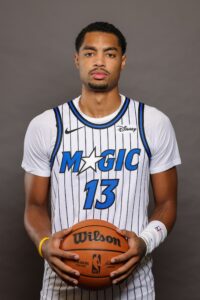 Kobe Bufkin
Kobe Bufkin Brandon Miller
Brandon Miller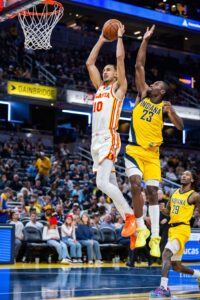 Alex Sarr
Alex Sarr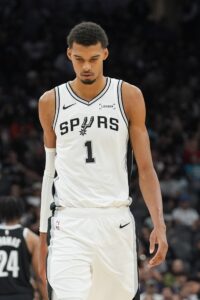 Incredibly, while the Spurs have been playing in the NBA for a half-century and have won five titles during that time, this is the first year the team has ever gotten off to a 5-0 start. As
Incredibly, while the Spurs have been playing in the NBA for a half-century and have won five titles during that time, this is the first year the team has ever gotten off to a 5-0 start. As 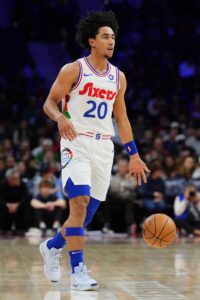 As
As 